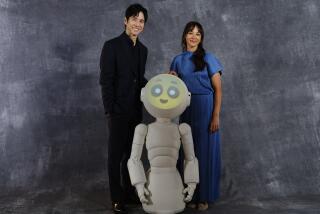Japanese Robots Wrestle With New Roles
- Share via
TOKYO — The arena comes alive with cheers and shouts when the referee signals for the bout to begin. Pushing and shoving, the wrestlers try furiously to drive each other toward the edge of the ring. It’s just like a real sumo tournament--except the wrestlers are robots.
Japan, a global leader in industrial robotics, is now turning out mechanical marvels that walk, talk and even swim--placing a new focus on robots that serve more as companion or entertainer than servant.
“Robots used to just do work,” says Fumio Kasagami, a robotics engineer at the machinery-maker Daihen Corp. “Now, they’re communicating with people.”
Robots have been widely used in Japanese manufacturing since the 1970s, about a decade after the technology was introduced here from the United States.
In 1997, there were 710,000 industrial robots being used in Japan, nearly 60% of the world’s total. Today, even with the nation’s flagging economy, a majority of industrial robots used worldwide are still made here.
But “bots” are by no means reserved for the factory assembly line. Robot competitions featuring everything from wrestling robots to computerized, maze-running “mice” have become the latest craze among teenagers and tech-junkies. Robocon Magazine, a bimonthly publication listing contests and construction techniques begun last year, claims a circulation of 55,000.
“The Japanese harbor good feelings about robots,” Hitoshi Matsubara, chief researcher at the national Electrotechnical Laboratory, wrote in a recent book on the subject.
*
One sign of that is the huge popularity of cartoons about robots and the booming sales in recent years of electronic pets like the Tamagotchi.
Though not as cuddly, robot pets are seen by many as having several distinct advantages over the real thing: They never soil the carpets, for instance, and if they die they can always be rebooted.
Matsubara foresees a future in which humanoid robots serve not only as nurses, maids and bodyguards, but as “partners who will play and talk with us.”
In Japan, that future seems not far away. The Japan Science and Technology Corp., a semiprivate research organization, has announced a 77-inch-tall bot that can dance, beat a drum and learn other movements by “watching” through a pair of camera eyes.
Sony Corp. has released a programmable pooch, and two other companies have made furry, computerized cats. Scientists at Mitsubishi Heavy Industries have come up with a lifelike robot fish.
Daihen has even introduced a computer-controlled robotic jester that tells jokes for money at an amusement park.
The new robots often are the whimsical spinoffs of research projects aimed at more serious applications.
But Masahito Fujita, who works in the Trade Ministry’s industrial machinery department, says the creation of more lifelike, intelligent robots is a step toward making machines capable of tough tasks that now only humans can do--such as caring for the elderly and performing dangerous rescue work.
Japan is still churning out new and improved industrial robots.
They’re getting smaller--like an ant-sized robot used for exploring pipes--and are more precise and sensitive enough to work with soft substances. “We’ve even got a robot that can pick up a block of tofu,” Fujita says.
Advances in computers have been a major factor in the current popularization trend. Computers and computer parts have become cheaper and better, allowing companies to experiment more and to get robots out of the factory and into the public marketplace.
*
The government also has been helping. Last year, it spent $8.8 million on robot research and development. In addition to urging schools to teach robotics, the government this spring held a robot demonstration at the residence of the speaker of Japan’s lower house of Parliament, with Prime Minister Keizo Obuchi in attendance.
“In the future, technology will support Japan,” said Tetsuhisa Shirakawa of Tokyo’s Science and Technology Agency. “We have to get young people interested in science.”
So far, it seems to be working.
More and more kids are competing in robot competitions. Kids like the members of the Robot Club at Tokyo’s Machida Technical High, last year’s champions in the All-Japan Robot Sumo Tournament.
The club’s nine members spent every day of their summer vacation training and honing their robots, sometimes staying to practice until late at night.
“Winning a contest with a machine you made yourself--that feels really good,” says Makoto Onuki, a senior.
More to Read
Sign up for Essential California
The most important California stories and recommendations in your inbox every morning.
You may occasionally receive promotional content from the Los Angeles Times.










